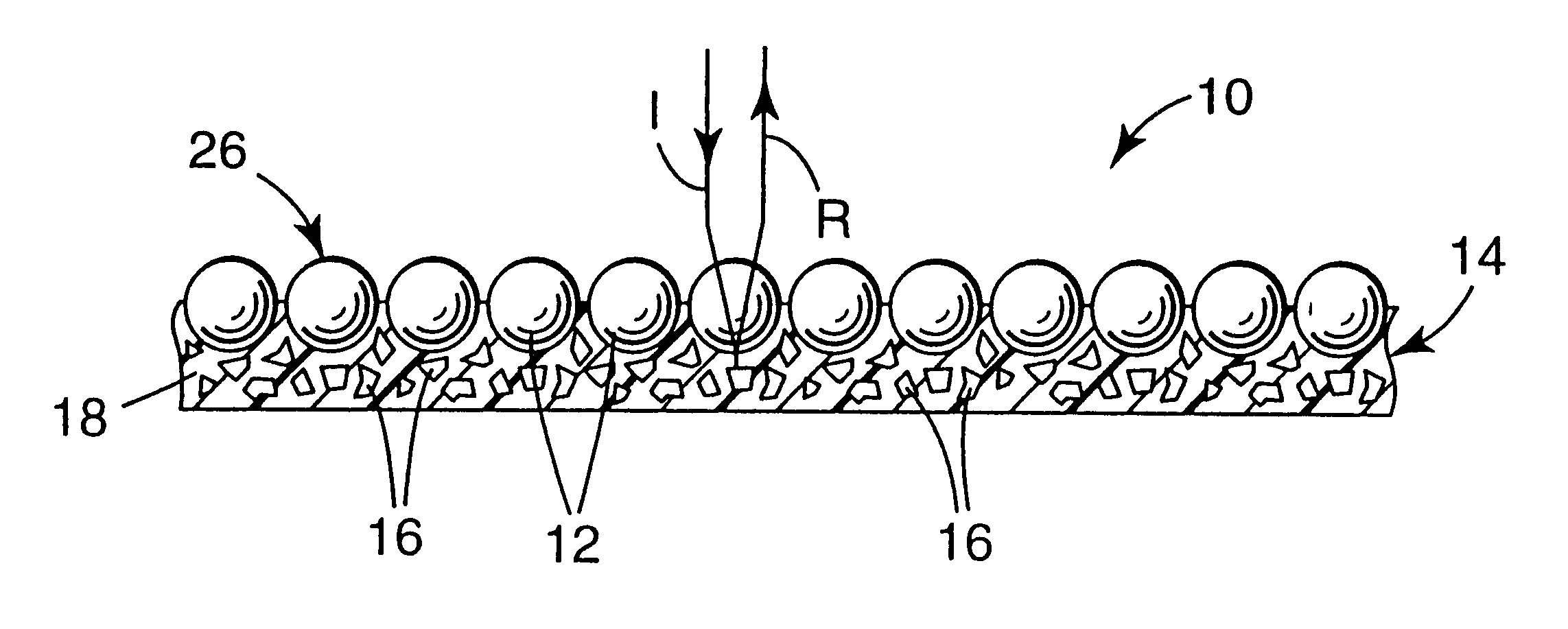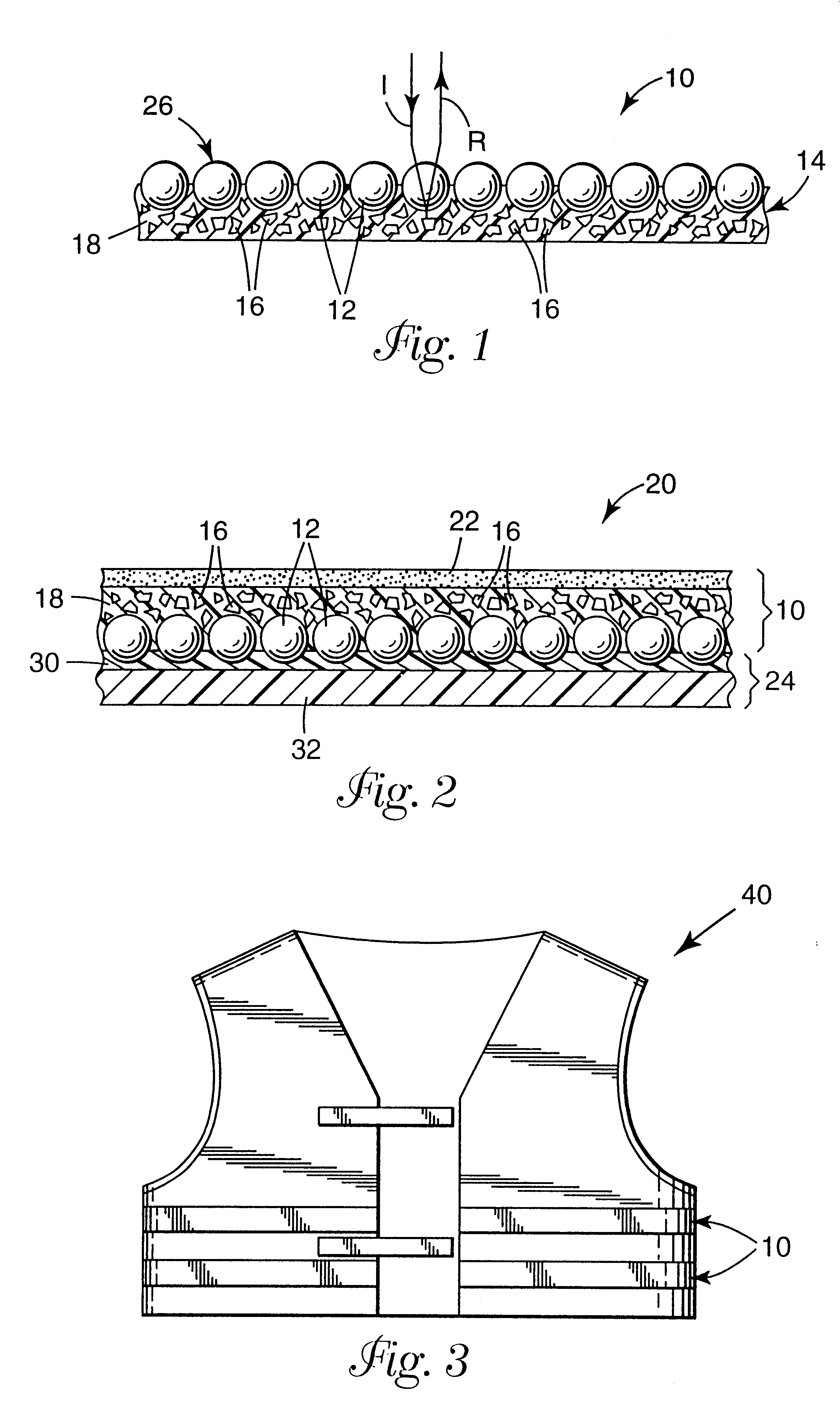Retroflective article having a colored layer containing reflective flakes and a dye covalently bonded to a polymer
a technology of reflective flakes and retroflective articles, which is applied in the direction of reflex reflectors, instruments, optical elements, etc., can solve the problems that the coloring techniques of one system are not necessarily applicable to the other, and the article cannot continue to serve the safety function after repeated washing, etc., to achieve good color performance, improve the loading level of reflective flakes, and improve the effect of reflection
- Summary
- Abstract
- Description
- Claims
- Application Information
AI Technical Summary
Benefits of technology
Problems solved by technology
Method used
Image
Examples
example 1
A microsphere carrier was prepared in the manner described in U.S. Pat. No. 5,474,827. Glass nicrospheres having a refractive index of about 1.9 and diameters of 40-90 micrometers were cascaded onto a polyethylene layer carried on a paper backing, in a manner which encouraged closest packing of the microspheres. The polyethylene layer was heated, and the microspheres were sunk into the polyethylene to a depth of about half the diameter of the nicrospheres so that a portion of the microspheres remained exposed above the surface of the polyethylene.
A colored layer coating solution was prepared by combining the following ingredients and stirring for 6 hours at 500 rpm with a propeller mixer:
44.42 grams (g) Acclaim .TM.2220 9.93 g Syn Fac .TM.8009 3.64 g Voranol .TM.234-630 29.05 g Afflair .TM.111
Then 43.65 grams of the above polyol / pearlescent solution was combined with 1.0 g Reactint.TM. X64 red dye, 7.62 g Mondur ML, 1.8 g A-1310, and 2 drops dibutyltinlaurate and stirred by hand. Th...
example 2
This example was prepared in the same manner as Example 1 but with the following changes.
A colored layer coating solution was prepared by combining the following ingredients and stirring for 2 hours at 500 rpm with a propeller mixer:
40.03 grams (g) Acclaim .TM.2220 9.94 g Syn Fac .TM.8009 3.63 g Voranol .TM.234-630 15.06 g Afflair .TM.111
Then 34.36 grams of the above polyol / pearlescent solution was combined with 1.05 g Reactint.TM. X15 yellow dye, 7.52 g Mondur ML, 1.87 g A-1310, and 2 drops dibutyltinlaurate and stirred by hand. The resulting precursor color coating solution was coated onto the microspheres of the beadcoat carrier using a notched bar coater having the metering bar set at a gap of 6 mils (150 .mu.m) above the surface of the microspheres. The coating was partially cured by forced air heating at 105.degree. C. (220.degree. F.) for 3 minutes. Fabric was then applied to the softened color layer and additional curing was conducted at 105.degree. C. (220.degree. F.) for 1...
example 3
This example was prepared in the same manner as Example 1 but with the following changes.
A colored layer coating solution was prepared by combining the following ingredients and stirring for 3 hours at 500 rpm with a propeller mixer:
40.06 grams (g) Acclaim .TM.2220 9.95 g Syn Fac .TM.8009 3.66 g Voranol .TM.234-630 30.01 g Afflair .TM.111
Then 41.83 grams of the above polyol / pearlescent solution was combined with 3.08 g Reactint.TM. X64 red dye, 7.51 g Mondur.TM. ML, 1.8 g A-1310, and 2 drops dibutyltinlaurate and stirred by hand. The resulting precursor color coating solution was coated onto the microspheres of the beadcoat carrier using a notched bar coater having the metering bar set at a gap of 6 mils (150 .mu.m) above the surface of the microspheres. The coating was partially cured by forced air heating at 105.degree. C. (220.degree. F.) for three minutes. Fabric was then applied to the softened color layer, and additional curing was conducted at 105.degree. C. (220.degree. F.) ...
PUM
| Property | Measurement | Unit |
|---|---|---|
| temperatures | aaaaa | aaaaa |
| diameter | aaaaa | aaaaa |
| diameter | aaaaa | aaaaa |
Abstract
Description
Claims
Application Information
 Login to View More
Login to View More - R&D
- Intellectual Property
- Life Sciences
- Materials
- Tech Scout
- Unparalleled Data Quality
- Higher Quality Content
- 60% Fewer Hallucinations
Browse by: Latest US Patents, China's latest patents, Technical Efficacy Thesaurus, Application Domain, Technology Topic, Popular Technical Reports.
© 2025 PatSnap. All rights reserved.Legal|Privacy policy|Modern Slavery Act Transparency Statement|Sitemap|About US| Contact US: help@patsnap.com


